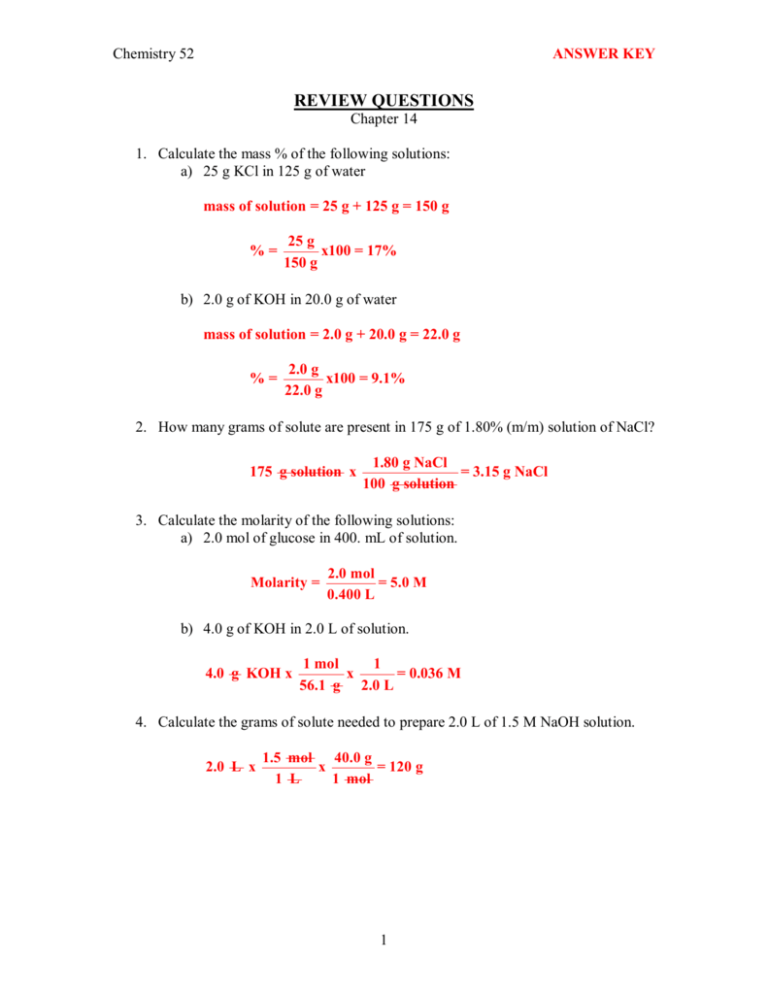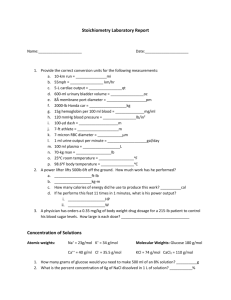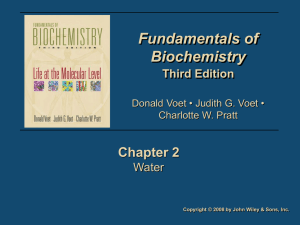review questions
advertisement

Chemistry 52 ANSWER KEY REVIEW QUESTIONS Chapter 14 1. Calculate the mass % of the following solutions: a) 25 g KCl in 125 g of water mass of solution = 25 g + 125 g = 150 g % = 25 g x100 = 17% 150 g b) 2.0 g of KOH in 20.0 g of water mass of solution = 2.0 g + 20.0 g = 22.0 g % = 2.0 g x100 = 9.1% 22.0 g 2. How many grams of solute are present in 175 g of 1.80% (m/m) solution of NaCl? 175 g solution x 1.80 g NaCl = 3.15 g NaCl 100 g solution 3. Calculate the molarity of the following solutions: a) 2.0 mol of glucose in 400. mL of solution. Molarity = 2.0 mol = 5.0 M 0.400 L b) 4.0 g of KOH in 2.0 L of solution. 4.0 g KOH x 1 mol 1 x = 0.036 M 56.1 g 2.0 L 4. Calculate the grams of solute needed to prepare 2.0 L of 1.5 M NaOH solution. 2.0 L x 1.5 mol 40.0 g x = 120 g 1 L 1 mol 1 5. How many grams of AgNO3 are needed to prepare 1500. mL of a 0.240 M solution? 1500. mL x 1 L 0.240 mol 169.9 g x x = 61.2 g 3 10 mL 1 L 1 mol 6. What volume of 0.300 M KCl will contain 15.3 g of KCl? 15.3 g KCl x 1 mol 1 L 10 3 mL x x = 684 mL 74.55 g 0.300 mol 1 L 7. A patient received 2.0 g of NaCl in 8 hours. How many mL of a 0.90% (m/m) NaCl (saline) solution were delivered to the patient? Density of solution is 1.05 g/mL. 2.0 g NaCl x 100 g solution 1 mL x = 210 mL 0.90 g NaCl 1.05 g 8. Calculate the freezing point of a solution prepared by dissolving 35.0 g of K2SO4 in 1000. g of water. (Kf = 1.86 °C/m) H 2 O K 2 SO 4 ¾¾¾ ® 2 K + + SO 4 2 i = 3 mol solute = 35.0 g x 1 mol = 0.201 mol 174.2 g molality of solution = 0.201 mol = 0.201 m 1.000 kg D Tf = i m K f = (3)(0.201 m )(1.86 o C/ m ) = 1.12 o C Freezing point (Tf ) = 0.00 1.12 = 1.12 o C 2 9. A solution is prepared by dissolving 5.00 g of NaCl in 25.0 g of water. a) Calculate the mass % of NaCl in this solution. % = 5.00 g x100 = 16.7% 5.00 g + 25.0 g b) Calculate the molality of this solution. mol NaCl = 5.00 g x molality = 1 mol = 0.0855 mol 58.45 g 0.0855 mol = 3.42 m 0.0250 kg c) Calculate the boiling point and freezing points of this solution. Kb=0.512 °C/m and Kf=1.86 °C/m NaCl (s) ® Na + (aq) + Cl – (aq) i = 2 DTb = i m Kb = 2 (3.42 m)(0.512 °C/m) = 3.50 °C Tb = 100.00 + 3.50 = 103.50 °C DTf = i m Kf = 2 (3.42 m)(0.1.86 °C/m) = 12.7 °C Tf = 0.00 – 12.7 = – 12.7 °C 10. A solution of antifreeze contains 25% by mass ethylene glycol (C2H6O2) in water. Calculate the boiling point and freezing point for this solution. 25% = 25 g C2 H 6O 2 100 g sol'n 1 mol = 0.40 mol 62.1 g mass of solvent = 100 g ­ 25 g = 75 g 0.40 mol molality = = 5.3 m 0.075 kg mol solute = 25 g x DTb = mK b = (5.3 m)(0.512 o C/m) = 2.7 oC Tb = 102.7 o C DTf = mK f = (5.3 m)(1.86 oC/m) = 9.9 o C Tf = ­ 9.9 o C 3 11. How many grams of ethyl alcohol (C2H5OH) are needed to drop the freezing temperature of 2.0 L of water to –10.0 °C? (Kf = 1.86 °C/m; 1 L water = 1 kg) DTf = 10.0 oC m = DT f 10.0 oC = = 5.38 m K f 1.86 o C/m m = mol solute mol solute = m x kg solvent = 5.38 m x 2.0 kg = 10.76 mol kg solvent mass of solute = 10.76 mol x 46 g = 490 g 1 mol 12. Which of the following solutions will have the greatest osmotic pressure? Explain. osmolarity = i x M 0.25 M C6H12O6 0.15 M NaCl 0.15 M CaCl2 1 x 0.25 M = 0.25 osmol 2 x 0.15 M = 0.30 osmol 3 x 0.15 M = 0.45 osmol The greater the osmolarity of a solution, the greater its osmotic pressure. Therefore, CaCl2 solution would have the greatest osmotic pressure. 13. Calculate the freezing point of an aqueous solution that boils at 102.5 °C. DTb = 2.5 o C DT b 2.5 o C m = = = 4.88 m K b 0.512 o C/m DTf = m K f = (4.88 m)(1.86 oC/m) = 9.1 oC Tf = ­ 9.1 oC 4 14. Two solutions, A and B, are separated by a semipermeable membrane as shown below. For each case below, determine which side rises due to osmotic pressure. a) A osmol B osmol 0.1M glucose 0.1 0.5M glucose 0.5 b) 1M NaCl 2 c) 0.5M KCl 1.0 d) 0.1M NaCl 0.2 0.1M glucose 0.1 0.5M K2SO4 1.5 0.5M KBr 1.0 In each case, the side with the higher osmolarity rises. Note that in (c), no side rises since osmolarity is equal in both sides. 15. Complete the equations below when each soluble ionic salt dissolves in water, and determine the i value for each: H 2 O a) Ca(OH)2 (s) ¾¾¾ ® Ca 2+ + 2 OH – i = 3 H 2 O b) NaC2H3O2 (s) ¾¾¾ ® Na + + C2H3O2 – i = 2 H 2 O c) NH4Cl (s) ¾¾¾ ® NH4 + + Cl – i = 2 H 2 O d) Li2CO3 (s) ¾¾¾ ® 2 Li + + CO3 2– i = 3 H 2 O e) Na3PO4 (s) ¾¾¾ ® 3 Na + + PO4 3– i = 4 5 16. In winter, after a snowstorm, salt (NaCl) is spread to melt the ice on the road. How many grams of salt must be added to 1000. g of ice to decrease its freezing point to –5.0 °C? (Kf = 1.86 °C/m) H 2 O NaCl ¾¾¾ ® Na + + Cl D Tf = i m K f m = molality = i = 2 DT f 5.0 o C = = 1.344 m i K f 2 (1.86 m/ o C ) mol solute mol solute = (1.344 m) (1.000 kg) = 1.344 mol 1.000 kg mass solute = 1.344 mol x 58.45 g = 78.6 g 1 mol 17. For each pair of solutions listed below, determine which will have the higher boiling point: osmol 3.0 2.0 a) 1.5 M NaCl and 0.5 M Al(NO3)3 osmol 4.0 2.0 b) 2.0 M NaOH and 2.0 M C6H12O6 Solutions with higher osmolarities will have the higher boiling points osmol 1.2 1.4 c) 0.4 M Na2CO3 and 0.7 M KCl 18. Both methanol (CH3OH) and ethylene glycol (C2H6O2) are used as antifreeze. Which is more effective–that is, which produces a lower freezing point if equal amounts of each are added to the same amount of water? Methanol would be more effective as antifreeze because it has a lower molar mass (32.0 g/mol) compared with ethylene glycol (62.1 g/mol), therefore producing more moles per gram of solute. 6







